Kala Bhairava is a fierce manifestation of Lord Shiva and is highly revered across the Indian subcontinent. He is depicted in an aggressive form with angry eyes shaped like lotus blossoms, blazing hair, tiger’s teeth, snake coiled around his neck or crown, and an eerie garland of human skulls. Often terrifying, Kala Bhairava carries a trident, a drum and the severed fifth head of Brahma. The deity is blue throated from swallowing poison to save the world. Hence, he is considered to be the vanquisher of death. His third eye represents eternal supreme wisdom.
There are many interesting legends surrounding Kala Bhairava, one of the eight avatars of Lord Shiva. The origin of the mighty god is attributed to a tale in the Shiv Mahapurana, wherein Lord Brahma commands Lord Vishnu to worship him, as he is the creator of the universe. This angers Lord Shiva, who is incarnated as Kala Bhairava to punish him and beheads one of Brahma’s five heads. Since then Brahma has four heads while Bhairava carries the fifth. But chopping off Brahma’s head amounted to the killing of a Brahman. Consequently, Bhairava had to carry the gory head with him for 12 years. He wandered like a vagabond, till he was liberated of the sin. Usually the idol of Bhairava depicts him in this frightful form.
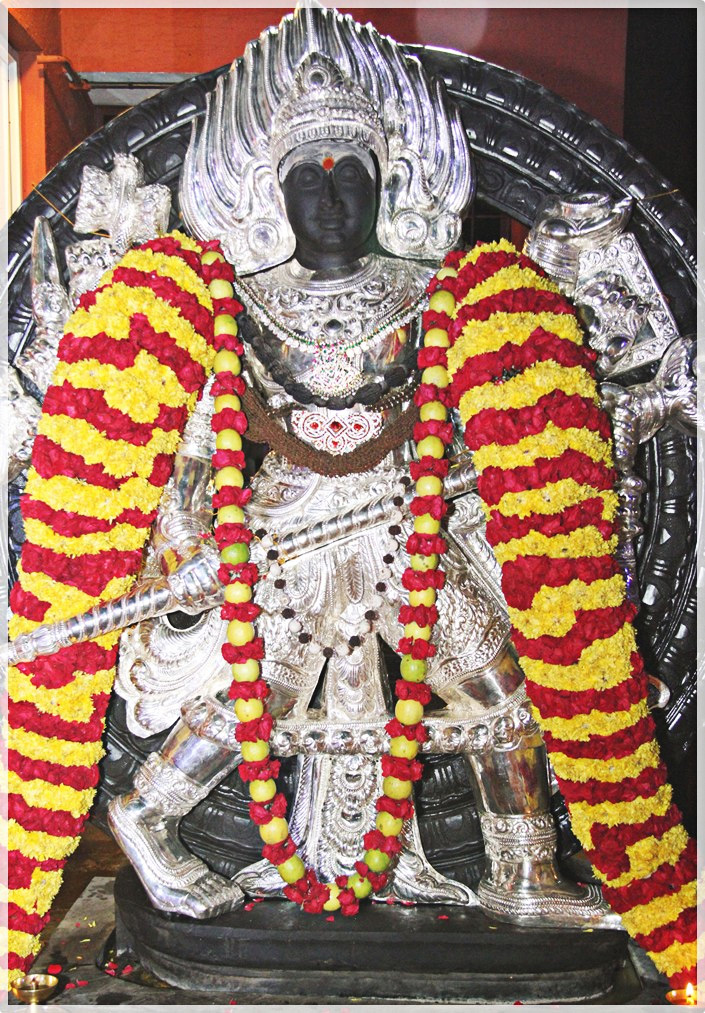
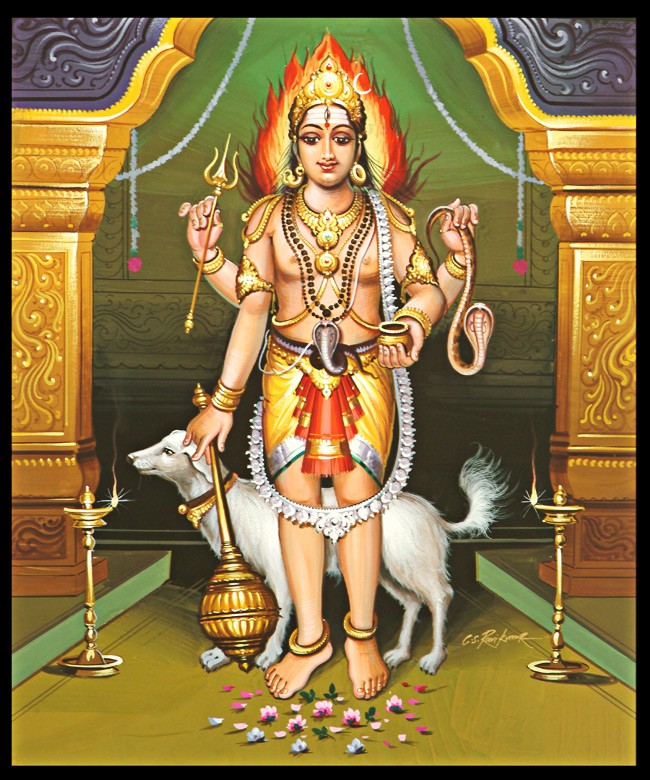
The name Bhairava itself is replete with deep meaning. The first syllable ‘Bhai’ means fear and also lustrous light. It is said to endow one with material wealth. ‘Rava ’ means echo. While ‘Ra’ casts off negativity and restricted consciousness, ‘Va’ keeps creating opportunities. In totality Bhairava denotes that by using fear we can attain ‘aseem anand’ or extreme delight.
Worshipped by Hindus, Jains and Buddhists alike, daily prayer offerings to Bhairava helps in achieving success, defeating enemies and attaining all materialistic comforts. He helps devotees fruitfully utilize their time in securing their goals. This is the reason why he is known as the Lord of Time. Wasting time in trivial pursuits can be diverted towards a constructive purpose, if one offers prayers and chants the name of Bhairava. He purifies souls with his sheer power and makes odds favorable for believers. Almost miraculously, one is at the right place at the right time for the best of opportunities.
Lord Bhairava is also known as ‘Kotwal’ or ‘Kshetpalaka’, the guardian of the temple. The keys to Shiva and Shakti temples are ceremonially submitted to Bhairava at closing time and received from him at the opening time in the morning. There is generally a shrine dedicated to him in the temple premise itself. He is also a guardian of the travellers and blesses those who visit on pilgrimage. The Siddhas state that before embarking on a journey, especially while travelling at night, one must light diyas (lamps) and garland Lord Bhairava with cashew nut wreaths. This assures protection and safety. For those abroad away from the blessed shores, the worship is equally important.
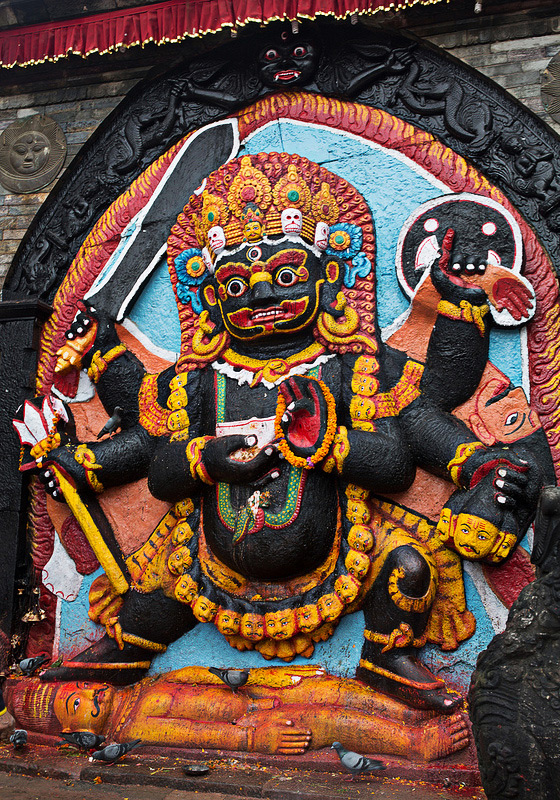
Despite being one of the most feared deities, he is essentially one of the most rewarding and protective gods. In tantric practices he is sacred as Batuk Bharav. Being a rudra, the Lord is said to be very knowledgeable in tantra-mantra.
Kala Bhairava is also famous for his dog vahana or vehicle. The dog is usually seated on one side, ready to taste the dripping blood from the executed Brahma head. Looking after and feeding dogs is thus considered to be another way of displaying devotion. Bhairava can bestow incredible blessings and the boon of auspicious time to devotees. According to myths, if one feeds hungry dogs with ‘halwa puri’ (sweet bread), then automatically all problems can be overcome.
People have always been worshipping Kala Bhairava from the days of yore. But according to the sacred texts the 60 years from the Chirtabhanu Year i.e. April 2002 to the next Chirtabhanu Year i.e. April 2062, is the most important time. The Ashtami after Poornima (the eighth day after full moon) is said to be the most ideal day for puja rituals. Practitioners celebrate Kala Bhairavashtami or Kala Bhairava Jayanti commemorating the day Kala Bhairava appeared on earth in the Margashirsha month of the Hindu calendar. There are elaborate ceremonies in the 12 Jyotirlinga Shiva shrines in Kasi, Tiruvannamalai, Ujjain and others, which have special rites and sacraments on this day.
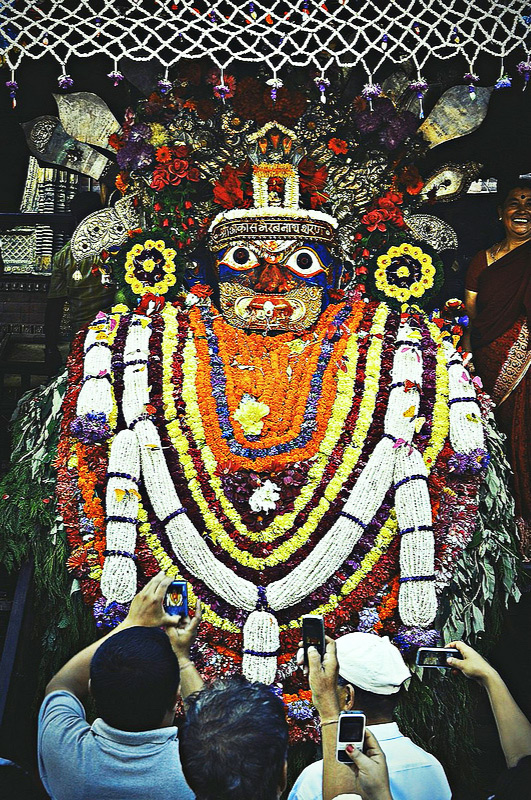
Kala Bhairava has 8 manifestations, namely Asithaanga Bhairava, Ruru Bhairava, Chanda Bhairava, Krodha Bhairava, Unmattha Bhairava, Kapaala Bhairava, Bheeshana Bhairava and Samhaara Bhairava. He also guards the 52 Shaktipeethas and hence there are said to be 52 forms of Bhairava across the sacred spots. Protecting Shakti is significant for everlasting peace amidst the scenarios of wrath, violence and animosity. Prayers to Lord Kala Bhairava as well as Sarabeswara and Amruta Mrityunjaya are necessary for this safeguarding.
From the Aghoris and Kapalika sect to Gorat Kashmiris, from Assamese tantric practitioners to the Gowdas of Karnataka, from worshippers in Kathmandu to those in Sri Lanka, across diverse communities Kala Bhairava is venerated. The Kashi (Benares) Bhairava is accorded much reverence. Hindu reformer Adi Sankara once wrote a beautiful hymn titled ‘Kala Bhairav Ashtakam’ in honor of the Kashi deity. In the rural milieu of Tamil Nadu, Maharashtra and others, he is believed to be the village protector. The villagers erect decorative statues of ‘grama devata’ at the village entrance.
The word Bhairava itself has considerable prominence in invocations. Chanting the three syllables ‘bhai’, ‘ra’ and ‘va’ is said to create a bounty of benefits. The sacred sound is said to be a reminder that each second is precious and that one should not procrastinate and disrespect time. Instead one must polish oneself by chanting and sharpen ones focus by chanting.
According to many gurus devotees must chant the syllables 8 times a day for a 1 minute each, anytime day or night. One can even chant the mantra more than 108 times or by writing 1008 or 10008 times for great outcomes and protection.
Thus, this fearful manifestation of Lord Shiva is believed to be one of the most protective powers blessing for humanity.
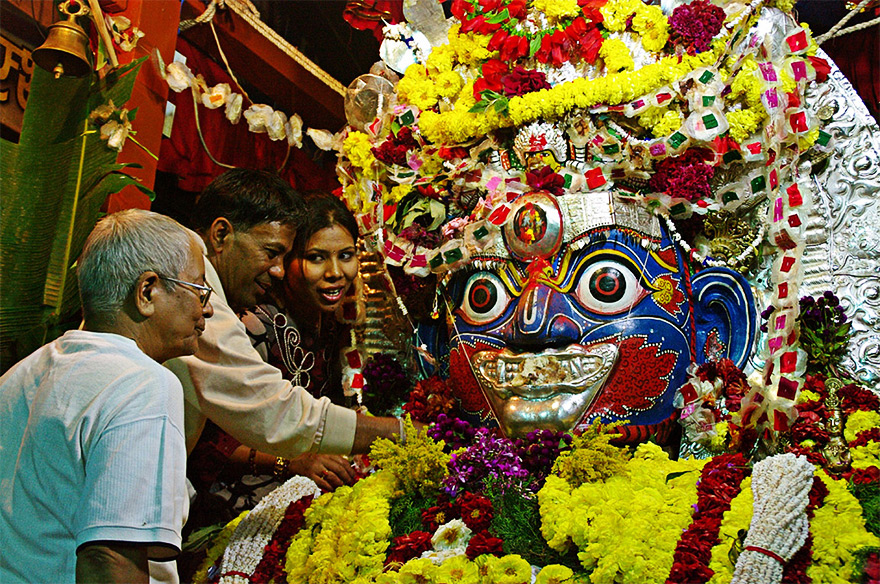
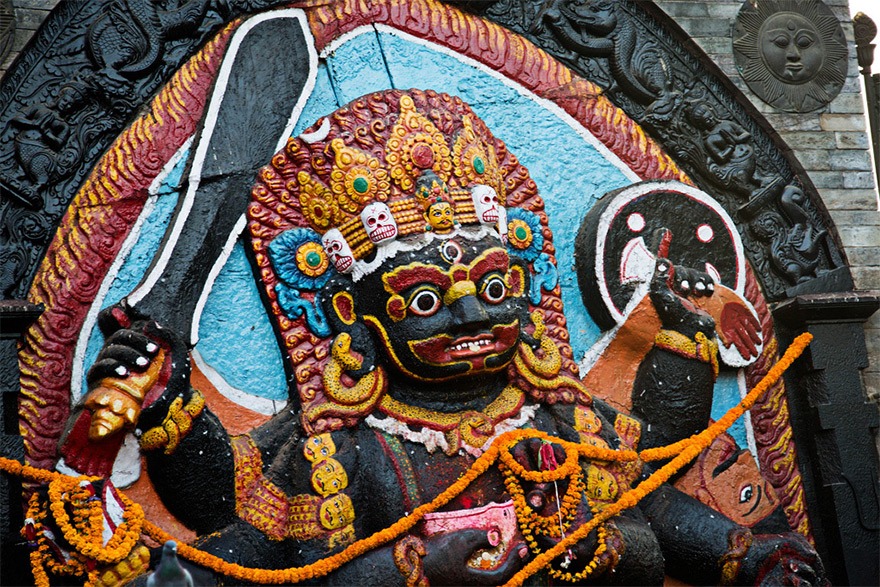
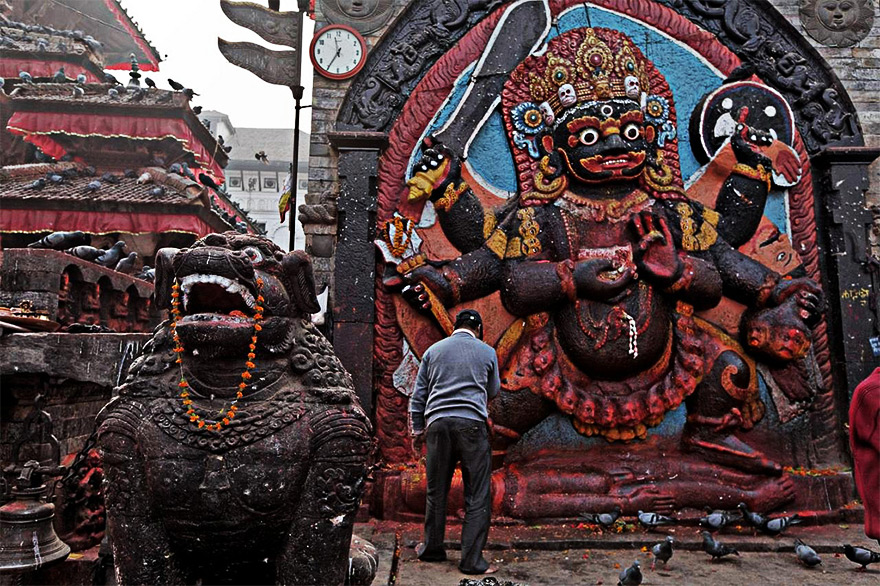
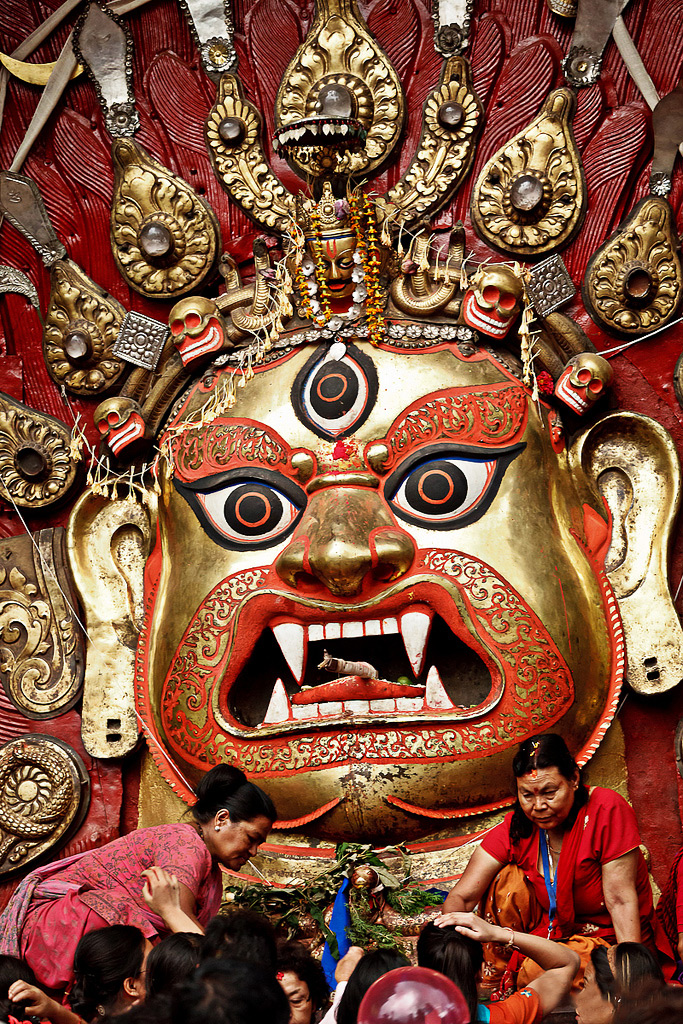

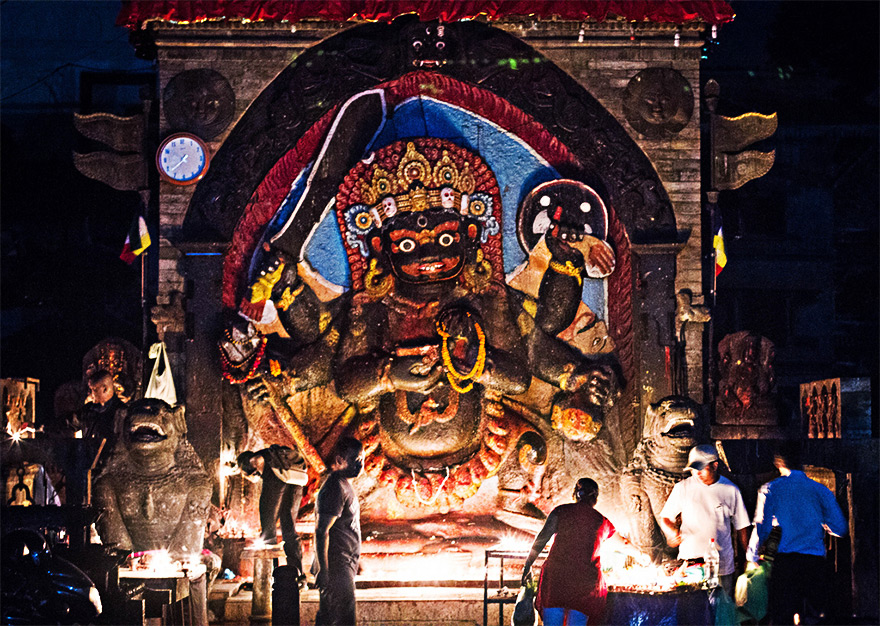











Very nice.
Can anybody upload KALABHAIRAVAASHTAKAM ?
Thanks. Very informative.
Thank you for giving lots of information. I am regularly and without missing reading all the information’s and yet times discuss among friends. Very glad. Thank you once again to all those who bring so much information for us.
Really informative, and also need to know the procedure how to per form pooja on the eighth day of full moon?
I have read about Kalbhairav katha in Shiv mahapuran, but did not know that much of details, so thank you for sharing this precious beneficialy chanting on Kalbhairav.
ஓம் காலகாலய வித்மஹீ.
கால தீதாய தீமஹி.
தந்நோ கால பைரவப் ப்ரசோதயாத்.
Hi Vaidyanathan
Good Day.
Below is Sri KaalaBhairavashtakam in English. I checked the text thoroughly and hope there may be no errors. In case if you need the Slogam in Hindi or Sanskirit, i will send it. Meaning of KaalaBhairavashtakam soon i will provide.
Om Ganapathaye Namaha
Sri KaalaBhairavashtakam
——-Sri AadhiSankara Bhagavat Paadhacharyaal Virachitham:
Slokam:
Devaraaja Sevyamaana paavanangri pankajam
Vyaala Yagnya ShoothraMindhu Sekharam Krupakaram
Naaradhadhi Yogi Vrindha Vandhitham Digambaram
Kaashika Puraadhinaatha KaalaBhairavam Bhaje —— 1
BaanuKoti Baasvaram Bhavapthi Thara Kamparam
Neelakanta Meepsidhaartha Dhayakam ThriLochanam
Kaala Kaalamambujaaksha Maksha Shoola Maksharam
Kaashika Puraadhinaatha KaalaBhairavam Bhaje ——2
Shoola Tanka Paasha Dhanda Paanimaadhi Kaaranam
Shyama Kaayamaadhi Deva Maksharam Niraamayam
Bheema Vikramam Prabhum Vichithra Thaandavam Priyam
Kaashika Puraadhinaatha KaalaBhairavam Bhaje ——3
Bhukthi Mukthi Dhaayakam Prashastha Chaaru Vigraham
Bhaktha Vatsalam Shivam(Sthitham) Samastha Loka Vigraham
Vinikvanan Manognya Hema KinKini Lasath Katim
Kaashikaa Puraadhinaatha KaalaBhairavam Bhaje ——-4
Dharma Sethu Paalakam TvaDharma Maarga Nashanam
Karma Paasha Mochakam SHuSharma DHayakam Vibhum
Swarna Varna Shesha Paasha Shobhi Thaanga Mandalam
Kaashika Puraadinaatha KaalaBhairavam Bhaje —-5
Rathna Paadhukaa Prabhabhi RamaPaadha Yugmaham
Nithyamadhwi theeya Mishta Dhaivatham Niranjanam
Mruthyu Dharpa Naashanam Karaala Damshtra Mokshanam
Kaashika Puraadhinaatha KaalaBhairavam Bhaje ——6
Attahasa Binnapadma Janta Kosha Santhathim
Drishti Paadha Nashta Paapa JaalaMugra Shaasanam
Ashta Siddhi Dhayakam KapaalaMaali Kandharam
Kaashika Puraadhinatha KaalaBhairavam Bhaje ——7
Bhootha Sanga Naayakam Vishaala Keerthi Dhayakam
KaashiVaasa Loka Punya Paapa Shodhakam Vibhum
Neethi Maarga Kovitham Puraathanam JagathPathim
Kaashikaa PuraadhinaathaKaalaBhairavam Bhaje —– 8
Phala Sruthi:
KaalaBhairavashtakam Patanthiyae Manoharam
Gnana Mukthi Saadhanam Vichithra Punya Vardhanam
Shoka Moha Dhainya Loba Kopa Thaapa Nashanam
Thae Prayaathi KaalaBhairava Vaangri Sannidhim Dhruvam ——9
Hope it helps.
Om Namo KaalaBhairavaaye Swamine!
Regards
Rudraswini
This is one of the most wonderful sites that has such wealth of information about Hindu religion,deities and also other invaluable topics that are always so much joy to read and share:) Sharing all your posts with gratitude:)
WONDERFUL
Kala Bhairava Ashtakam
Very useful and highly informative. Thanks a lot.
All Bhairava pictures are excellent. Narration is also nice. Good information, yet brief.
VERY AUTHRITATIVE FACTS and PHOTG DEPICTIONS…..
Thanks
Thanks for your unmatched work.
0M
Very useful and highly informative.
Pray of KaalBhairava is solution of any problem,
Thanks a lot.
Jay kalbhairav
We live in a world with closed eyes , not for meditating but with a myopic or translucent vision leaving the real values and admiring the fake ones .
Is kaala bhairo the same kaala bhairava
Thanks for giving lot of information.
I need kaala bhairava mantra in Telugu script.
(Recently I am suffering with lot of fear, I don’t know how it is entered in my mind. Most of the time I am unable to sleep in the night).
Please give me kaala bhairava mantra for Fear less. So that I will be more beneficial.
Thanking U
Sanjay
Yes, Kaal Bhairo and Kaala Bhairava refer to the same divine aspect.
The more I read and search, I learn a lot, thus gaining knowledge and eventually wisdom!
Thank you, aap ka bahoot bahoot dhanyavaad!
WHAT I HAVE HEARD OF KALA BAIRAVA – Lord of time. Its is in some verse some where but hidden and invisible. Probably Kumbeswara puraanam might throw some light. Masters in Vedha might quote correctly. For a star of SUN’s mass, 70 to 120 million miles (112 to 198 m kms) is called HABITABLE DISTANCE. Less than that distance, it is too hot to harbour life. Beyond 120 m miles, it is too cold to harbour life. Imagine this as a disc. Currently Earth is at 19.8 m kms from sun. Universe is expanding. Whereas Viswam is all inclusive (infinity) and jagat is ever mutating and changing, brahmaa (not grahma) means ever expanding. Planetary bodies keep moving away from their host star and planetary systems are expanding and galaxies that hold planetary systems also keep expanding. When a planet that holds life moves away from habitable distance extreme, there is PRALAYAM at which time the seed (beejam) of life is kept in a kumba [Probably Noah’s arc]. ANyway Cosmic consciousness (Sudhdha chaitanya) is the one that manifests as sthoola vastu (vyaktham) as well as Sookshma chetanam. So life’s seed need not be objectified or materialised or manifested form. Until a planet comes in to habitable distance disc, this seed is protected and then the kumbha is sent back to the surface of that planet . The time life is sustained between 70 to 120 m miles (or proportional to STAR’s mass to the sun), is one BRAHMAA’s day. At pralayakalam, Brahmaa goes to sleep and Kaala bairava wakes up and protects the beejam. Posssibly the form attributed to Kaala bairava may be due to the nature of Brahmaa’s night. And it is possible that there are 33 crore such systems in this universe (signifying beyond counting in mortal numbers). This perfectly jels with scientific concept of habitable distance . Even satellites to a planet are always within a ring disc that are proportional to planet’s mass. COMMENTS welcome
Rudraswini Please provide in deva nagari lipi
there are mistakes in many versions i think. even here in this .
kapaala maalikaa dharam is correct and not kapaala maalikandaram, I think.
Also ,
karaala dhamshtra booshanam or karaala dhamshtra mokshanam ?
nikvanan manogna or vinikvanan manogna ?
only when we see word by word meaning, it will become clear